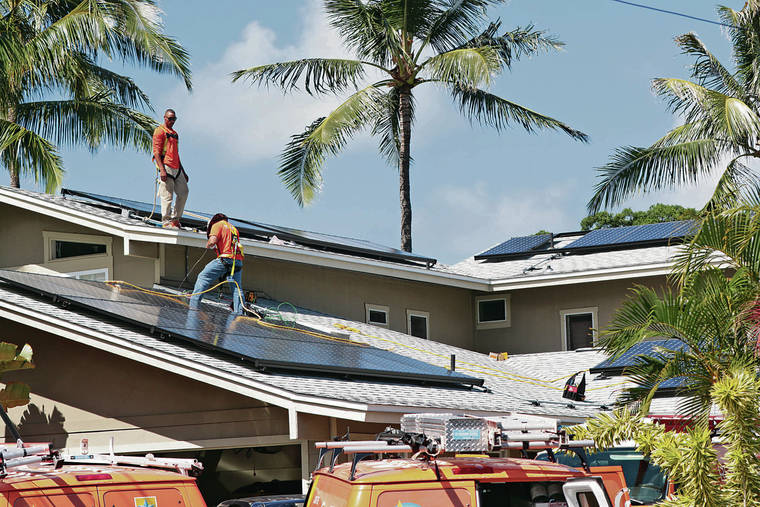Hawaii is set to see shrinking utility costs and growing renewable energy after the state Public Utilities Commission’s landmark decision to change the way Hawaiian Electric makes its money.
In a decision and order more than 200 pages long Opens in a new tab
issued last week, the PUC established a “performance- based regulation” framework that separates the profits of Hawaii’s largest utility from capital investments, or a “cost-of-service” approach.
The new performance-
based regulation provides
financial incentives for Hawaiian Electric to achieve customer and policy-oriented performance goals, such as increased savings for lower-income customers and the reduction of greenhouse gases.
The PUC in its order said that “customers will benefit from lower utility costs and see greater integration of renewable energy resources.”
Hawaii had started moving away from the old cost-of-service business model in 2010 after establishing “decoupling” mechanisms that separate electricity sales from utility profits.
In the past, electrical companies earned more money if customers used more electricity, so they didn’t have an incentive to reduce electricity consumption.
Decoupling was an attempt to break the link between electrical utility profits and customer electricity consumption.
With decoupling, utilities are more likely to take a neutral stance on efforts to increase energy efficiency or promote the installation of rooftop solar panels, which reduce electricity sales. The problem was that decoupling “does not really offer financial upside from these programs,” said James Griffin, chairman for the PUC, in an email statement.
Performance-based regulations will offer a financial upside to encourage electrical utilities to support energy
efficiency and rooftop solar, Griffin said.
The new framework is intended to be beneficial for both Hawaiian Electric and customers.
The PUC order said performance-based regulations will provide Hawaiian Electric with financial opportunities to earn “rewards for exemplary and high-quality service.”
“Hawaiian Electric will have much stronger financial interests to control their costs and achieve clean energy goals,” Griffin said. “We intend for this to be win-win for the public and utility.”
Others shared that sentiment.
“It’s been a long road, but the Commission’s bold decision puts ‘cost-plus’ regulation in the rear view mirror,” said Ron Binz, former chairman of the Colorado Public Utilities Commission and expert for Blue Planet Foundation, in a statement. “This decision puts Hawaii in the lead nationally by reforming regulation to achieve a ‘win-win-win’ for customers, the utility, and the environment and climate.”
Blue Planet, in a news release, said the current model is “a roadblock to progress, where (Hawaiian Electric) made money by building and maintaining its own centralized infrastructure. This created an inherent bias toward postponing the retirement of fossil-fuel plants, expending capital on utility-owned projects, and deterring customers from installing rooftop solar.”
Hawaiian Electric declined to comment, saying it was still reviewing the order.
Griffin said based on preliminary estimates using current sales, typical customers on Oahu could see savings of $17 on their electrical bill in 2021, which would steadily grow to $25 in 2025. On Hawaii island those savings would grow from $23 to $33, and for Maui residents they would increase to $30 from $22.
While those are small savings for individual households — the monthly residential electric bill in Hawaii averaged $162 in 2019, according to a report by the Hawaii State Energy Office Opens in a new tab — in total, ratepayers could save tens of millions of dollars per year under the performance-based regulation framework, and additional savings could be realized as more renewable-energy projects come online.
Griffin said it’s difficult to determine how much renewable energy will grow under the new framework, but said there’s a “strong incentive” for Hawaiian Electric to add more.
The price of electricity in Hawaii is the highest in the country Opens in a new tab, and in many cases several times more expensive than in other states, according to data from the Energy Information Administration. In October, Hawaii residents paid nearly 29 cents per
kilowatt-hour — more than
double the 13.6 cents per kilowatt-hour for the nation as a whole.
The price of electricity, along with gasoline, in Hawaii fluctuates with the price of crude oil, which Hawaii is heavily reliant on for its energy needs, according to the the state Energy Office.
No other state relies on petroleum products for energy as much as Hawaii. Only 11% of Hawaii’s energy comes from renewable sources.

